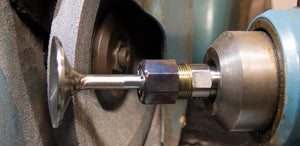Use mineral based grinding oils for best results.
Mineral based oils cool while grinding so you won't burn the surfaces of your valves. These oils also help remove particles and inhibit rust.
Choose the right stone for the right material
Valve grinding is NOT a one abrasive fits all proposition. Different materials require different abrasives. General Purpose wheels are intended for your basic, bread and butter, everyday passenger car valves. They are a great starting point but they won't do everything. Yes, it would be great is a single stone would work for every valve (it sure would simplify our inventory) but that isn't the case. You cannot get by with a single stone.
As valve manufacturers are using increasingly complex metal alloys to reduce weight, increase strength, improve heat tolerance, the job of valve grinding becomes more complex which is why you'll see such a large selection of valve refacing stones in the Goodson catalog. You must test and experiment to find what works the best for you and what you're grinding.
It may seem a waste of time to be changing grinding wheels just because the valve material changed. In the long run, though, you're saving time. You could easily waste an hour trying to grind a valve with the wrong abrasive. Isn't it worth the few minutes it'll take to change the wheel?
A quick tip from an old machinist ... group your jobs together based on the stone you have on the valve refacer. Do all of your stainless valves at the same time, swap to a stone for stellite and do those, etc. Work smarter, not harder.
Use a sharp diamond when dressing for best results.
We can't say this enough — sharp diamonds are essential. Not only do they cut faster, but they give a superior finish. Always, always, always check your diamond before beginning to dress your stone. If it's starting to get rounded, rotate it to a different point or order a new one. You'll do more harm than good with a dull diamond.

